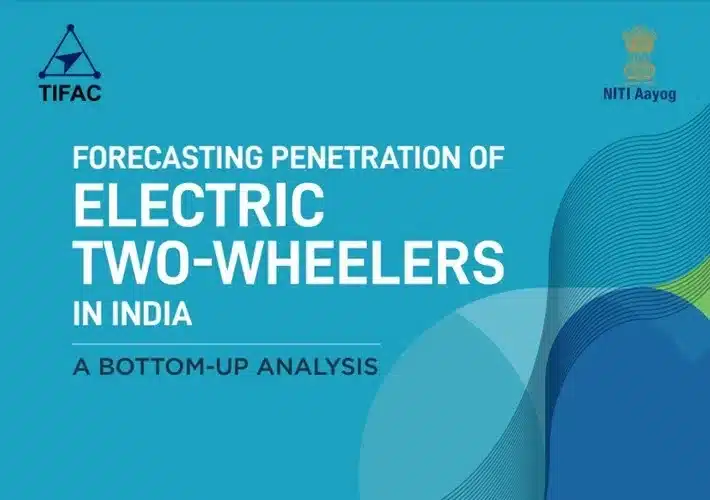NITI Aayog and TIFAC Launch Report on Future Penetration of Electric Two-Wheelers in the Indian Market

NITI Aayog and TIFAC launched a report titled ‘Forecasting Penetration of Electric Two-Wheelers in India’, on 28 June.
Using a tool made by NITI Aayog and TIFAC, eight scenarios have been developed for analyzing the future penetration of electric two-wheelers in the country.
In an optimistic scenario, the report forecasts 100% penetration of electric two-wheelers in the Indian market by FY 2026–27. In another scenario, which is technology driven and where current incentives are withdrawn by 2024, the report predicts 72% penetration by 2031.
During the launch of the report, NITI Aayog CEO Amitabh Kant said, “This report provides a much-needed tool to the industry, researchers, academicians, and policymakers to analyze and respond to various scenarios. It can be replicated easily in other segments too, such as four-wheelers, without any hassle.”
The eight scenarios considered are:
- Challenged Diffusion
- Performance Driven
- Low Battery Cost
- Technology Driven
- Incentive Driven
- Battery Cost Challenged
- Same Performance
- Optimistic
The future scenarios have been constructed on the basis of three major factors that influence the market penetration of electric two-wheelers: (i) demand incentives (ii) cost of battery (iii) vehicle performance in terms of both range and power.
Four broad constraint levels have also been identified for the eight scenarios, in terms of installed vehicle manufacturing capacity and available charging infrastructure: (i) full constraint (where both vehicle production and charging infrastructure are constraints) (ii) production constraint (where only vehicle production is a constraint) (iii) charge constraint (where only the charging infrastructure is a constraint) (iv) no constraint.
Highlights:
- In the ‘Technology Driven’ scenario, if an R&D programme manages to enhance the range and power of electric two-wheelers by 5% annually between FY 2023–24 and 2025–26, and by 10% in FY 2026–2027, then the penetration of electric-two wheelers may reach about 72% in FY 2031–32—even with no extension of demand incentives.
- The sale of electric two-wheelers may cross 220 lakh units in FY 2028–29 under the ‘Optimistic’, ‘Same Performance’ and ‘Battery Cost Challenged’ scenarios. It may reach 180 lakh units under the ‘Technology-Driven’ scenario. Under the ‘Incentive Drive’ scenario, the sale is expected to reach only 55 lakh units in FY 2031.
- If there is sufficient installed capacity of electric two-wheelers and charging infrastructure, then sale (which finally reaches about 250 lakh units) may at some point even surpass the production under the ‘Optimistic’, ‘Same Performance’ and ‘Battery Cost Challenged’ scenarios.
The report provides important insights into the required infrastructure, manufacturing capability, policies, and technology-development priorities in the area.
The scenarios can be used by government agencies, the industry, and academic/R&D institutions for evidence-based analysis of policies, market scenarios and technology development strategies.
Read the report here: https://www.niti.gov.in/sites/default/files/2022-06/ForecastingPenetration-ofElectric2W_28-06.pdf
Observer Voice is the one stop site for National, International news, Sports, Editor’s Choice, Art/culture contents, Quotes and much more. We also cover historical contents. Historical contents includes World History, Indian History, and what happened today. The website also covers Entertainment across the India and World.

